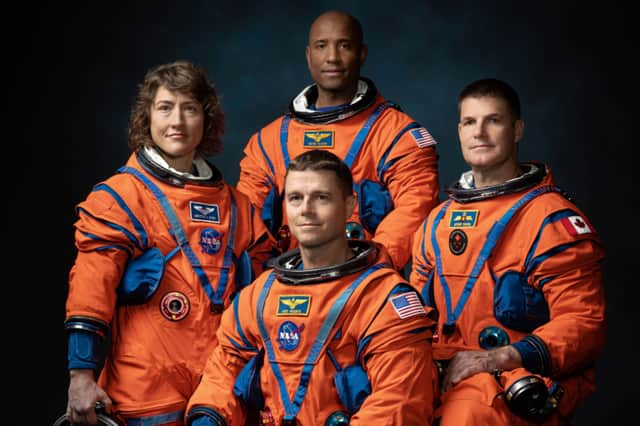Artemis 2: Nasa mission to Moon launch date, who are the crew - including Christina Koch and Victor Glover


Nasa and the Canadian Space Agency (CSA) have named the four astronauts who will fly around the moon late next year, including the first woman and the first African American assigned to a lunar mission.
The first Moon crew in 50 years — three Americans and one Canadian — was introduced during a ceremony in Houston, home to the United States’ astronauts as well as Mission Control. “This is humanity’s crew,” said Nasa administrator Bill Nelson.
Advertisement
Hide AdAdvertisement
Hide AdLast year, Nasa’s Artemis I mission was a success. The unmanned voyage around the Moon - the flight was transporting mannequins rather than people - was the next step in re-establishing a human lunar presence, and paved the way for the crewed Artemis II flight test and eventual human lunar exploration.
The Artemis II flight test will be Nasa’s first mission with astronauts who will fly around the moon in over 50 years. The last manned mission to the moon was Apollo 17 in December 1972.
If successful, Artemis II will pave the way to land the first woman and next man on the moon as part of Artemis III. Here is everything you need to know about it.
What is the mission?
Artemis II will involve sending a crewed Orion spacecraft to perform a lunar flyby test and return to Earth.
Advertisement
Hide AdAdvertisement
Hide AdThe Orion spacecraft will be launched into a high Earth orbit that will last for about 42 hours, during which time the crew will perform various checks of the spacecraft's life support systems, as well as an in-space rendezvous and proximity operation demonstration.
Then, the Orion spacecraft will fire its main engine to complete a trans lunar injection (TLI) to send it on towards an orbit of the Moon, before returning to Earth. The entire mission is currently planned to take 10 days, though the crew could spend a maxium of three weeks in space if it is needed.
The mission won’t actually land on the surface of the moon, as Nasa is testing a wide range of new technologies, systems and procedures during Artemis II, many of which have never been tested in a real spaceflight setting.
Nasa will need to gather data on these in order to inform its future Moon to Mars ambitions envisioned under the Artemis programme, so the the agency has decided that a lunar fly-around is the best and safest course of action.
When will Artemis II take place?
Advertisement
Hide AdAdvertisement
Hide AdA crewed Artemis II voyage around the moon is currently scheduled to be launched by the Space Launch System (SLS) in November 2024.
That launch window could be delayed until later in 2024 or the first quarter of 2025 however, due to the need to recycle and refurbish Orion parts that were used on the Artemis I mission.
What are Nasa’s Artemis missions?
The mission was originally intended to collect samples from a captured asteroid in lunar orbit by the now canceled robotic Asteroid Redirect Mission, but was repurposed and renamed after the introduction of the Artemis program.
The Artemis missions are part of Nasa’s long-term plans to build a space station – called Lunar Gateway – where astronauts will be able to live and work.
Advertisement
Hide AdAdvertisement
Hide AdThe building of the Lunar Gateway will include contributions from scientists and engineers in the UK, including from Thales Alenia Space UK and Imperial College London, with backing from the UK Space Agency.
If Artemis II is a success, it will open the door for Artemis III, which will send the first woman and next man to the moon. As for when that mission might take place, NASA has said it hopes to return astronauts to the lunar surface by 2025.
Who is on the Artemis II crew?
The mission’s commander, Reid Wiseman, will be joined by Victor Glover, an African American naval aviator; Christina Koch, who holds the world record for the longest spaceflight by a woman; and Canada’s Jeremy Hansen, a former fighter pilot and the crew’s lone space rookie.
Wiseman, Glover and Koch have all lived on the International Space Station. All four are in their 40s. “This is a big day. We have a lot to celebrate and it’s so much more than the four names that have been announced,” said Glover.
Advertisement
Hide AdAdvertisement
Hide AdThis is the first moon crew to include someone from outside the US — and the first crew in Nasa’s new moon programme named Artemis after the twin sister of mythology’s Apollo.
“Am I excited? Absolutely,” Koch said to cheers from the crowd of schoolchildren, politicians and others. “But my real question is: ‘Are you excited?’” she said to more cheers.
The Canadian Space Agency snagged a seat because of its contributions of big robotic arms on Nasa’s space shuttles and the space station. One is also planned for the moon project. Hansen said he is grateful that Canada is included in the flight.
“We are going to the moon together. Let’s go!” he said.
Comment Guidelines
National World encourages reader discussion on our stories. User feedback, insights and back-and-forth exchanges add a rich layer of context to reporting. Please review our Community Guidelines before commenting.
